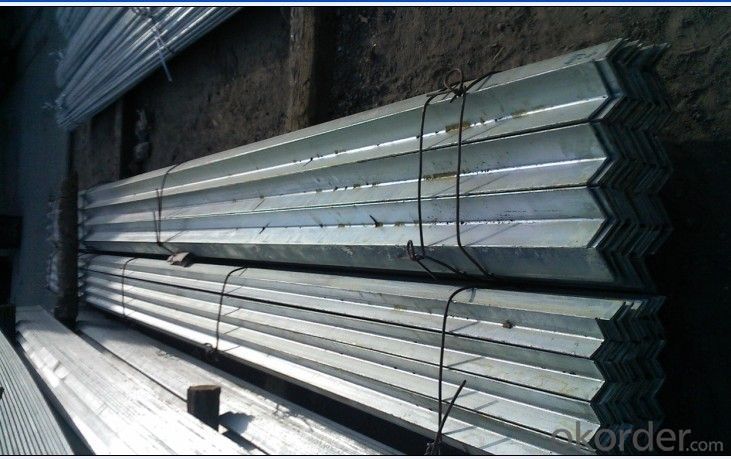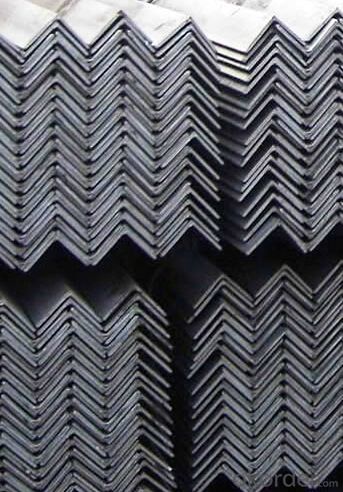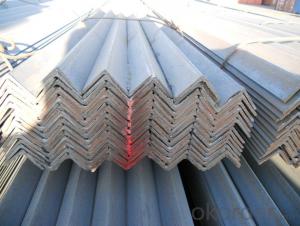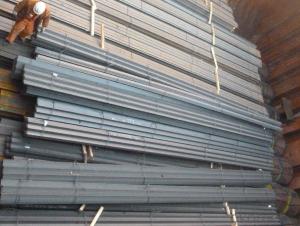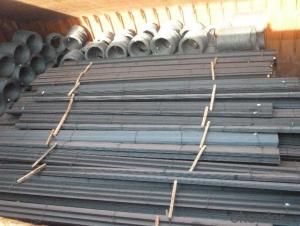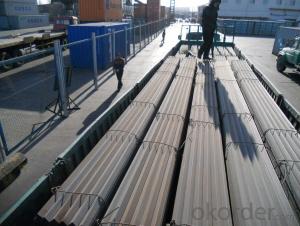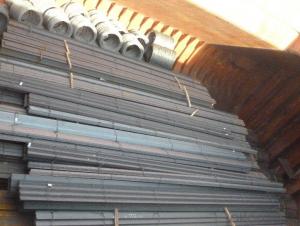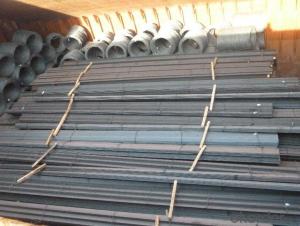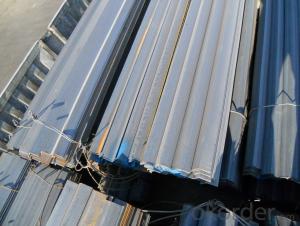Hot Rolled Steel Equal Angle Bar ASTM Standard
- Loading Port:
- Tianjin
- Payment Terms:
- TT or LC
- Min Order Qty:
- 50 m.t.
- Supply Capability:
- 20000 m.t./month
OKorder Service Pledge
OKorder Financial Service
You Might Also Like
OKorder is offering Hot Rolled Steel Equal Angle Bar ASTM Standard at great prices with worldwide shipping. Our supplier is a world-class manufacturer of steel, with our products utilized the world over. OKorder annually supplies products to African, South American and Asian markets. We provide quotations within 24 hours of receiving an inquiry and guarantee competitive prices.
Product Applications:
Hot Rolled Steel Equal Angle Bar ASTM Standard are ideal for structural applications and are widely used in the construction of buildings and bridges, and the manufacturing, petrochemical, and transportation industries
Product Advantages:
OKorder's Hot Rolled Steel Equal Angle Bar ASTM Standard are durable, strong, and wide variety of sizes.
Main Product Features:
· Premium quality
· Prompt delivery & seaworthy packing (30 days after receiving deposit)
· Can be recycled and reused
· Mill test certification
· Professional Service
· Competitive pricing
Product Specifications:
Manufacture: Hot rolled
Grade: Q195 – 235
Certificates: ISO, SGS, BV, CIQ
Length: 6m – 12m, as per customer request
Packaging: Export packing, nude packing, bundled
EQUAL ANGLES SIZES |
| ||
a(mm) | a1(mm) | thickness(mm) | length |
25 | 25 | 2.5---3.0 | 6M/12M |
30 | 30 | 2.5---4.0 | 6M/12M |
38 | 38 | 2.5 | 6M/12M |
38 | 38 | 3.0---5.0 | 6M/12M |
40 | 40 | 3.0---6.0 | 6M/12M |
50 | 50 | 3 | 6M/12M |
50 | 50 | 3.7---6.0 | 6M/9M/12M |
60 | 60 | 5.0---6.0 | 6M/9M/12M |
63 | 63 | 6.0---8.0 | 6M/9M/12M |
65 | 65 | 5.0---8.0 | 6M/9M/12M |
70 | 70 | 6.0---7.0 | 6M/9M/12M |
75 | 75 | 5.0---10.0 | 6M/9M/12M |
80 | 80 | 6.0---10.0 | 6M/9M/12M |
90 | 90 | 6.0---10.0 | 6M/9M/12M |
100 | 100 | 6.0---12.0 | 6M/9M/12M |
120 | 120 | 8.0-12.0 | 6M/9M/12M |
125 | 125 | 8.0---12.0 | 6M/9M/12M |
130 | 130 | 9.0-12.0 | 6M/9M/12M |
140 | 140 | 10.0-16.0 | 6M/9M/12M |
150 | 150 | 10---15 | 6M/9M/12M |
160 | 160 | 10---16 | 6M/9M/12M |
180 | 180 | 12---18 | 6M/9M/12M |
200 | 200 | 14---20 | 6M/9M/12M |
FAQ:
Q1: Why buy Materials & Equipment from OKorder.com?
A1: All products offered byOKorder.com are carefully selected from China's most reliable manufacturing enterprises. Through its ISO certifications, OKorder.com adheres to the highest standards and a commitment to supply chain safety and customer satisfaction.
Q2: How do we guarantee the quality of our products?
A2: We have established an advanced quality management system which conducts strict quality tests at every step, from raw materials to the final product. At the same time, we provide extensive follow-up service assurances as required.
Q3: How soon can we receive the product after purchase?
A3: Within three days of placing an order, we will arrange production. The normal sizes with the normal grade can be produced within one month. The specific shipping date is dependent upon international and government factors, the delivery to international main port about 45-60days.
Images:
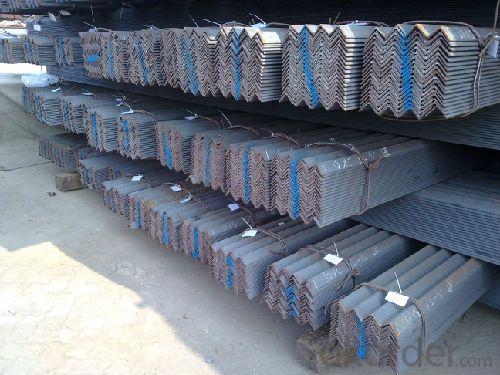
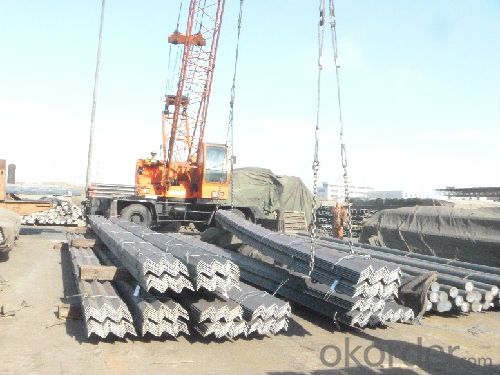
- Q: Can steel angles be used for structural applications?
- Yes, steel angles can be used for structural applications. They are commonly used in construction and engineering projects to provide structural support, stability, and reinforcement. Steel angles have excellent strength-to-weight ratio, high durability, and versatility, making them suitable for various structural applications such as framing, bracing, trusses, and supports.
- Q: What are the common industry standards for steel angles?
- The American Society for Testing and Materials (ASTM) primarily determines the common industry standards for steel angles. ASTM A36, widely recognized as a standard for structural steel angles, finds common usage in construction and industrial applications. This standard specifies the chemical composition, mechanical properties, and other relevant characteristics of the steel angles. Another commonly used standard, ASTM A572, is specifically designed for high-strength low-alloy (HSLA) steel angles. It provides guidelines for the chemical composition, mechanical properties, and notch toughness of the angles. Additionally, several other ASTM standards, including A529, A588, and A992, dictate the requirements for specific types of steel angles used in different applications. By ensuring that steel angles meet the necessary quality and performance criteria, these standards enable consistent and reliable use across various industries.
- Q: How do steel angles contribute to the overall durability of a structure?
- Steel angles, also known as angle irons or L-shaped structural steel, play a significant role in enhancing the overall durability of a structure. These versatile components are commonly used in construction projects due to their ability to provide strength, stability, and support. Firstly, steel angles are designed to withstand heavy loads and forces. By distributing the weight evenly, they help to prevent structural failures and ensure the longevity of the building. This is particularly important in applications where the structure is subjected to dynamic forces such as wind, earthquakes, or heavy machinery. Moreover, steel angles serve as effective reinforcements in critical areas of a structure. They are often used to reinforce connections between different structural members, such as beams and columns, creating a robust framework. This reinforcement enhances the overall load-bearing capacity of the structure, allowing it to withstand greater loads without compromising its integrity. Additionally, steel angles provide lateral stability to a building. By connecting various components diagonally, they help to resist horizontal forces, such as those caused by wind or seismic activity. This lateral stability is crucial in preventing the structure from swaying or collapsing under extreme conditions, ultimately ensuring the safety of occupants. Furthermore, steel angles are highly resistant to corrosion, which is a common cause of deterioration in structures. The use of galvanized or stainless steel angles can significantly reduce the risk of rusting and subsequent degradation. This corrosion resistance contributes to the long-term durability of the structure, reducing maintenance costs and prolonging its lifespan. In summary, steel angles are essential in enhancing the overall durability of a structure due to their ability to withstand heavy loads, provide reinforcement, offer lateral stability, and resist corrosion. By incorporating steel angles into construction projects, engineers can ensure the structural integrity and longevity of buildings, ultimately creating safer and more durable spaces.
- Q: Can steel angles be used for support brackets in electrical installations?
- Indeed, support brackets for electrical installations can certainly utilize steel angles. In construction, steel angles are frequently employed and offer robust support for a multitude of applications, including electrical installations. These angles possess impressive strength and durability, enabling them to withstand the weight and stress imposed by supporting electrical components or fixtures. Furthermore, steel angles can be effortlessly affixed to walls, ceilings, or alternative surfaces, thereby establishing a reliable foundation for electrical equipment such as junction boxes, conduit, or cable trays. Furthermore, steel angles can be tailored and fabricated to accommodate precise installation specifications, rendering them an adaptable selection for support brackets in electrical installations.
- Q: Galvanized steel angles under what conditions?
- Galvanized angle itself coated zinc and iron rust, common need to be coated with a layer of anti rust paint in the construction process, so the galvanized angle in the construction without paint. Suitable for field and outdoor support and Engineering
- Q: What are the limitations of using steel angles in high-temperature applications?
- One of the limitations of using steel angles in high-temperature applications is their susceptibility to thermal expansion. Steel, like most materials, expands when heated and contracts when cooled. This property can lead to dimensional changes in the steel angles, which may affect their structural integrity and performance. Another limitation is the potential for steel angles to lose their strength and hardness at elevated temperatures. As the temperature increases, the steel can undergo a process called tempering, where its hardness decreases and it becomes more ductile. This can lead to reduced load-bearing capacity and increased susceptibility to deformation or failure under high loads or stresses. Moreover, steel angles are prone to oxidation and corrosion at high temperatures. When exposed to oxygen and moisture in the air, steel can form iron oxide or rust. This can weaken the steel angles and compromise their structural integrity, especially in environments with high humidity or aggressive chemical agents. Furthermore, steel angles may also experience a phenomenon called creep when subjected to high temperatures and constant loads. Creep refers to the gradual deformation or elongation of a material under a constant stress over time. This can result in permanent deformation and compromise the structural stability of the steel angles. Lastly, the design and fabrication of steel angles for high-temperature applications require careful consideration of the material's thermal conductivity. Steel has relatively high thermal conductivity, which means it can transfer heat quickly. This property can result in uneven heating and cooling of the steel angles, leading to potential stress concentrations or thermal gradients that could affect their performance. Considering these limitations, it is important to carefully evaluate the suitability of steel angles for high-temperature applications and consider alternative materials or design modifications to ensure optimal performance and safety.
- Q: Can steel angles be used in architectural lighting installations?
- Indeed, architectural lighting installations can incorporate steel angles. Given their robustness, longevity, and adaptability, steel angles are frequently employed in construction ventures. Within the realm of architectural lighting, these steel angles serve as a foundation for illuminating apparatuses, as well as fixtures for wall or ceiling-mounted lights, or even as a framework for track lighting systems. Moreover, steel angles can be effortlessly tailored and fabricated to satisfy precise design specifications, thereby rendering them appropriate for a diverse range of architectural lighting applications.
- Q: What are the load-bearing capacities of different steel angle sizes?
- The load-bearing capacities of different steel angle sizes vary depending on several factors such as the material grade, the angle size, and the length of the angle. Generally, larger steel angle sizes have higher load-bearing capacities compared to smaller sizes. To determine the load-bearing capacity of a specific steel angle size, it is crucial to consider its moment of inertia, which is a measure of its resistance to bending. The moment of inertia increases with the size of the angle, resulting in higher load-bearing capacities. Additionally, the yield strength of the steel used in the angle also plays a significant role in determining its load-bearing capacity. Yield strength is the maximum stress that a material can withstand without permanent deformation. Steel angles with higher yield strength are capable of carrying heavier loads. It is important to consult engineering resources such as steel design manuals or structural engineers to obtain accurate load-bearing capacity information for different steel angle sizes. These resources provide tables and formulas that consider the specific dimensions and properties of the angle to calculate the maximum allowable load it can bear safely. In conclusion, the load-bearing capacities of different steel angle sizes depend on various factors including the angle size, material grade, and yield strength. Consulting reliable engineering resources is necessary to obtain accurate load-bearing capacity information for specific steel angle sizes.
- Q: Can steel angles be used for framing windows or doors?
- Framing windows or doors is indeed possible with steel angles. In construction, steel angles are widely employed for their robustness and endurance. As framing material, they offer essential support and stability. Moreover, steel angles can be easily tailored and trimmed to the desired length, rendering them suitable for framing windows and doors of different dimensions. Furthermore, by welding or bolting steel angles together, a robust frame can be fashioned capable of enduring substantial loads and furnishing the indispensable support for windows and doors.
- Q: How do you inspect and measure the dimensions of a steel angle?
- To inspect and measure the dimensions of a steel angle, the following steps can be followed: 1. Tools required for the task are a measuring tape or ruler, a protractor, and a square. 2. Begin by examining the length of the steel angle. Place one end of the measuring tape or ruler on one side of the angle and extend it to the opposite side. Make sure the measuring tape is straight and aligned with the edge of the angle. Read the measurement in inches or millimeters to determine the length. 3. Proceed to measure the width or thickness of the angle. Position the measuring tape or ruler perpendicular to the length of the angle and measure the distance between the two parallel sides. This will provide the width measurement. 4. To measure the height or depth of the angle, position the measuring tape or ruler perpendicular to the width measurement. Again, ensure that the measuring tape is aligned with the edge of the angle and measure the distance between the two sides. This will yield the height measurement. 5. To verify the accuracy of the angle being 90 degrees, employ a square. Place the square against one side of the angle and ensure alignment with the adjacent side. Check if the corner of the angle fits perfectly within the square. If it does, the angle is indeed 90 degrees. If not, adjustments may be necessary. 6. Lastly, if the angle of the steel angle needs measurement, a protractor can be employed. Align one side of the protractor with one side of the steel angle and observe where the other side intersects with the protractor scale. Read the angle measurement to determine the exact angle. By adhering to these steps and utilizing the appropriate tools, one can effectively inspect and measure the dimensions of a steel angle.
Send your message to us
Hot Rolled Steel Equal Angle Bar ASTM Standard
- Loading Port:
- Tianjin
- Payment Terms:
- TT or LC
- Min Order Qty:
- 50 m.t.
- Supply Capability:
- 20000 m.t./month
OKorder Service Pledge
OKorder Financial Service
Similar products
Hot products
Hot Searches
Related keywords



